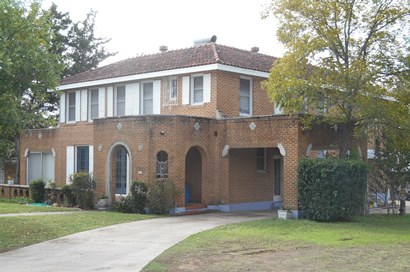Books by
Michael Barr
Order Here: |
|
The
biggest celebrity to come out of Kerrville
is not Johnny Manziel but a trailblazing singer and songwriter who
became an American music icon.
Jimmie Rodgers was born on September 8, 1897 in Mississippi or Alabama.
At 14 he got a job with the railroad and worked his way up to brakeman
- all the while playing his guitar and singing in the evenings.
Then in 1924 Rodgers contracted tuberculosis. The disease sapped his
strength and made it hard to hold a steady job.
While looking for work in Asheville, North Carolina, Rodgers heard
that the Victor Talking Machine Company would be holding auditions
for local musicians across the state line in Tennessee. On a blistering
August day in 1927, this frail, unemployed railroad worker walked
into a portable recording studio in Bristol and cut loose with a haunting
World War I ballad called
"The Soldier's Sweetheart." That song rocketed the Singing Brakeman
to stardom. |
Less than a
year later, at the Earle Theater in Washington, D. C., Rodgers sang
a blues classic called "Frankie and Johnny" and tore the house down.
He returned for 16 curtain calls. By 1930 he was a superstar, selling
out venues all over the country and making $100,000 a year. Every
village and town in America knew his name, and his music could be
heard throughout the English-speaking world.
Rodgers made his mark in country music when the genre was sneezed
at by most prominent entertainers, but his recordings of "Blue Yodel"
(better known as "T for Texas"), "Waiting for a Train," and "In the
Jailhouse Now" sold millions. His fusion of hillbilly, blues, and
jazz appealed to a national audience. Among the starry-eyed boys who
crowded around the Victrola to hear him sing and yodel were Ernest
Tubb, Gene
Autry, Hank Snow, Roy Acuff, Tex
Ritter, and Hank Williams. His music inspired Muddy Waters, Chuck
Berry, Little Richard, and Elvis Presley.
In 1929 Rodgers traveled to Texas looking for a warm, dry climate
that might extend his life. That spring he arrived in Kerrville
- the home of his business manager Dick Jarrard. Rodgers took a fancy
to Kerrville.
He and his family rented a house on Earl Garrett Street while he built
his dream house, "Blue Yodeler's Paradise," on top of a hill at 617
Main Street. |
 |
Blue Yodeler's
Paradise
Photo
courtesy Michael Barr |
|
Many of Rodgers'
Hill Country
neighbors got to hear him live for the first time on his 1930 Coast
to Coast Tour. He played the Majestic Theater in San
Antonio (January 9), the Palace Theater in Fredericksburg
(January 28), the BurnTex Theater in Burnet
(February 3), the LanTex Theater in Llano
(February 4 and 5), the Schwethelm Theater in Comfort
(March 2), and the Ritz Theater in San
Saba (March 7 and 8).
But each year tuberculosis robbed him of his vitality and his resources.
In 1931 he sold "Blue Yodeler's Paradise" to pay his medical bills
and moved to an apartment in San
Antonio.
As his disease got the better of him, his voice grew sadder by the
day. Then in 1933, rail thin, bone-tired, and road weary, Rodgers
traveled to New York to make ten new Victor records. He recorded
his last song on May 24. Two days later he died in his room at the
Taft Hotel on 51st Street in New York. He was 35 years old.
Jimmie Rodgers is the only artist inducted into the Country Music
Hall of Fame, Rock and Roll Hall of Fame, and Blues Hall of Fame.
As for Johnny Manziel and the Hall of Fame, the jury is still out.
© Michael Barr
"Hindsights by Michael Barr"
December
1, 2015 Column
|
Sources:
Kerrville Mountain Sun, April 25, 1929, "Famous Singer to Make Home
in Kerrville," p.1.
Kerrville Mountain Sun, February 27, 1930, p.8.
Kerrville Sun Times, September 5, 1929, p.1.
San Saba News, March 6, 1930, p.3.
The Burnet Bulletin, January 30, 1930, p.1.
Llano News, February 6, 1930, p.1.
Fredericksburg Standard, January 25, 1930, p.1. |
|
|
|
